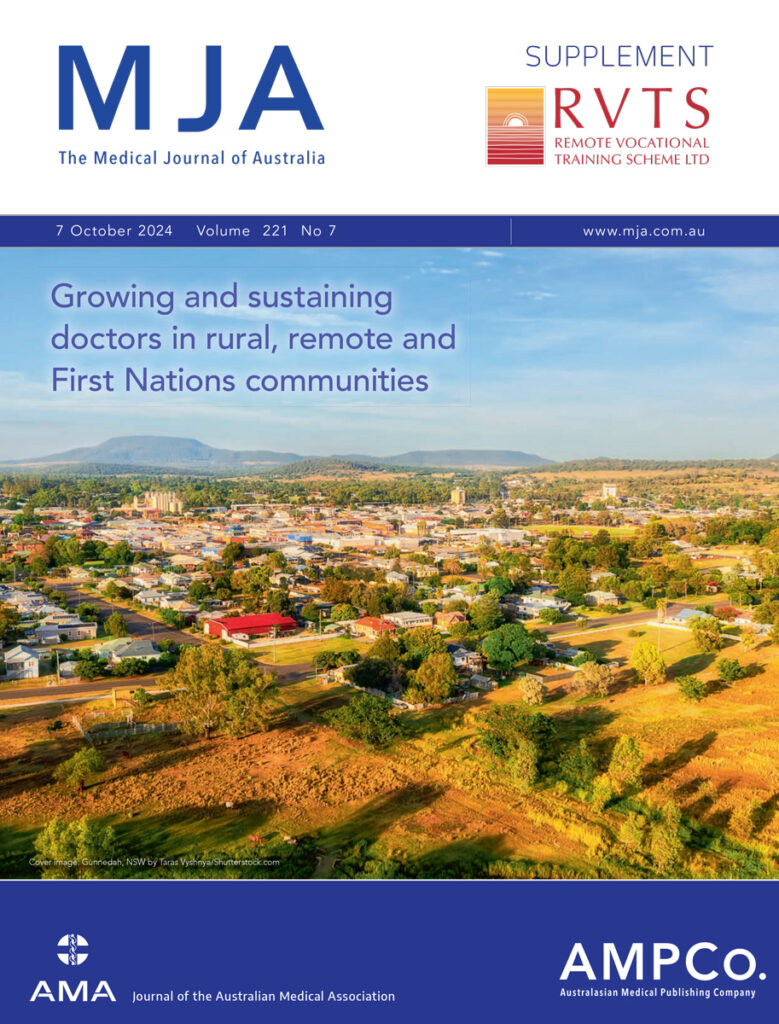Training general practitioners and rural generalists in the same practice over a number of years in rural and remote areas has benefits to the community, health services and supports the retention of doctors in these areas.
The latest supplement in the Medical Journal of Australia studies the Remote Vocational Training Scheme (RVTS). The RVTS is an independent rural general practice workforce and training program and has been fully funded by the Department of Health and Aged Care since 2000.
RVTS supports vocational general practice and rural generalists training for the Royal Australian College of General Practitioners (RACGP) and Australian College of Rural and Remote Medicine (ACRRM).
The RVTS provides online and face-to-face supervision for remote and isolated doctors. It also supports vocational training for the rural Aboriginal Medical Services (AMS). One of the unique aspects of RVTS is that it requires doctors to continue to work in the same practice while completing the three to four years of practice-based GP training. This is longer than other general practice models and also includes one year of hospital-based training.
Retention of primary care workers has a big impact in remote locations, as high turnover and resulting lower value care impacts patients, with increased hospitalisations and the resulting costs of replacing staff. For example, in the Northern Territory, halving turnover of primary care workers and reducing short term staff is projected to save $32 million each year.
Although it’s been in operation since 2000, this is the first time the outcomes and effectiveness of the RVTS have been holistically described.

Continuing of service and longer term retention of doctors as general practitioners in the RVTS
This descriptive cohort study used retrospective administrative data for doctors who participated in RVTS from 2000 to 2023.
The findings showed strong continuity of service and retention outcomes in remote communities and rural AMS over a 24-year timeframe. About half of the doctors stayed working in the same community for another two years.
“On a positive note, one in three remote stream participants stayed in the same community or a similar MMM4–7 community, suggesting that the program contributes to the national agenda for a distributed generalist workforce,” the authors of the study said.
“Place-based retention-focused programs like the RVTS could play a role in reducing the direct and indirect costs of remote health workforce turnover.”
Because of the retention rate of the RVTS, the authors recommend, “reconsidering the role of place-based retention-focused approaches to promote access to quality services in communities with relatively high needs”.
“Our findings suggest that with careful selection and program design in specific places, and supervision and support for resilience and retention in challenging contexts, continuity of service and longer term retention outcomes can be achieved well above benchmark standards,” the authors said.
“This can reduce costs and improve quality of services for remote and First Nations communities.”
Recruitment
The authors explored the five-year pilot of the collaborative Targeted Recruitment Strategy that has been led by the RVTS that started in 2018. As a result, they recommend improvements in current strategies for attracting and retaining new general practitioners in high need communities.
“Our research identified that the Targeted Recruitment Strategy could be more differentiated and targeted, with the bundle of initiatives for each location more clearly defined and carefully implemented.”
“It is also suggested that defining clear agency roles and responsibilities, along with shared risk management and quality processes, is important before the strategy is expanded.”
“Despite the importance of this issue, there is little published evidence on implementing collaborative approaches to attract and retain new general practitioners in high need communities,” the authors said.
Perceived stakeholder benefits of continuously training in the same rural or remote practice: interviews exploring the RVTS
International medical graduates make up 82% of RVTS doctors, indicating a reliance on this cohort in remote areas.
“They are supported by a holistic remote supervision and distance education model, which achieves over 90% satisfaction,” the authors reported.
“The RVTS model was perceived to offer diverse benefits for different system stakeholders, which could improve quality of learning, service delivery and community care.”
The study identified benefits to training GPs and rural generalists in the same rural and remote practices over the training period. The benefits flow onto communities, health services, doctors and policy makers.
“The findings reinforce that this approach could benefit a culturally attuned, place connected workforce and mitigate the cost and time related to remote workforce turnover.”
The authors conclude that the RVTS is seen as beneficial for low resource communities.
“Its approach has enabled these communities to access doctors who receive supported training over a three- to four-year timeframe which contributed to improvement of service quality and overall skills of rural, remote and First Nations health care teams.”
Read the supplement in the Medical Journal of Australia.
Subscribe to the free InSight+ weekly newsletter here. It is available to all readers, not just registered medical practitioners.

 more_vert
more_vert
RVTS does great work and the key to its success is that it is a doctor-led model, meaning there is a clear understanding of the work and what the candidates are to achieve.
Congratulations to Dr Pat Giddings OAM and his team!
One really significant reason for choosing to work in a remote, needy place is the chance to make a difference. The potential is huge for a satisfying life.